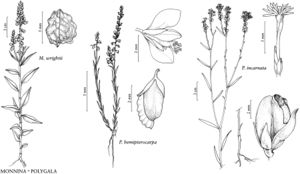Difference between revisions of "Monnina wrightii"
Smithsonian Contr. Knowl. 5(6): 31. 1853.
imported>Volume Importer |
imported>Volume Importer |
||
| Line 51: | Line 51: | ||
|publication year=1853 | |publication year=1853 | ||
|special status= | |special status= | ||
| − | |source xml=https://xjsachs2@bitbucket.org/aafc-mbb/fna-data-curation.git/src/ | + | |source xml=https://xjsachs2@bitbucket.org/aafc-mbb/fna-data-curation.git/src/e39f0e846f172941159b2045254d62d10d9823f6/coarse_grained_fna_xml/V10/V10_459.xml |
|genus=Monnina | |genus=Monnina | ||
|species=Monnina wrightii | |species=Monnina wrightii | ||
Latest revision as of 10:32, 9 May 2022
Herbs (2–)3–6(–7) dm. Stems branched distally, hairs incurved. Leaves: petiole 1–2.5 mm; blade mostly lanceolate or narrowly ovate to elliptic, sometimes obovate proximally, 15–60 × 2–10 mm, base cuneate, apex usually acute to attenuate-acuminate, sometimes obtuse proximally. Racemes 2–20(–30) × 0.3–0.6 cm; peduncle to 6 cm; bracts narrowly lanceolate or ovate-subulate. Pedicels 0.4–0.5 mm, pubescent. Cleistogamous flowers usually present on much-reduced axillary branches, chasmogamous flowers sometimes absent, 1.5–2.1 mm. Flowers: non-wing sepals ovate to lanceolate, 1.2–1.8 mm; wings obovate, 1–2 mm wide; keel 1.5–3 mm. Fruits ovoid, subglobose, or subobovoid, 3–5 × 2.8–4 mm. Seeds 2–3 mm.
Phenology: Flowering (mid–)late summer–fall.
Habitat: Igneous, limestone, gravelly, sandy, or silty loam soils, in dry to moist, open to shaded grasslands, shrublands, woodlands, disturbed areas.
Elevation: 1200–2600 m.
Distribution
Ariz., N.Mex., Mexico (Chihuahua, Colima, Durango, Guanajuato, Jalisco, Michoacán, Nayarit, Sinaloa, Sonora, Zacatecas), South America.
Discussion
Monnina wrightii is amphitropically disjunct in Argentina and Bolivia, with single collections each from Peru and Uruguay.
Selected References
None.
